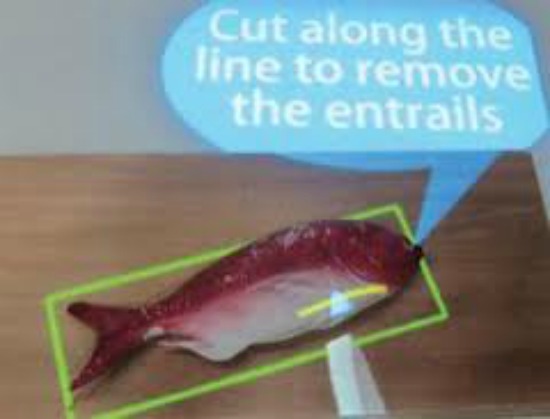Cooking With Robots
Along with motion-sensing cameras and projectors creating augmented reality, they’ll likely be among the tools training chefs of the future
/https://tf-cmsv2-smithsonianmag-media.s3.amazonaws.com/filer/20120820122027yu-suzuki-small.jpg)
![]()

Kitchen tech teaches chefs to cut along a virtual line. Photo courtesy of Kyoto Sangyo University
Last week The Voice was back. I’m not referring to the treacly TV show or the latest crooner chased down by TMZ. I’m talking about Julia Child.
In honor of what would have been her 100th birthday, America’s first real TV chef was all over the airwaves. Or at least her voice was, a voice that, on first hearing, sounded like it could set off car alarms, or maybe was a car alarm. But it was all part of the package, a presence as genuine as it was gangly. There was nothing snooty about Julia as she taught Americans French cooking. If you dropped a piece of lamb and you were alone in the kitchen, she once confided to viewers, just pick it up. No one had to know.
So it was no small irony that the day after her birthday, the New Scientist’s website published a piece about how robots, sensors and augmented reality are now being used to train novice chefs. It’s good that Julia never had to hear about this.
Something’s watching you
Nonetheless, this is where cooking is headed, a future where precision and skill in the kitchen will have as much to do with what’s watching as who’s training.
Consider the setup that computer scientist Yu Suzuki and his team have created in a test kitchen at Kyoto Sangyo University. They’ve installed cameras and projectors on the ceiling that project cooking instructions right on the ingredients.
So, let’s say you want to filet a fish. Once you place it on a chopping board, the camera detects its size and shape and the projector then overlays the equivalent of a virtual dotted line showing you where to make the cut. In a macabre twist, instructive word bubbles appear at the fish’s mouth to ensure that his gutting is done properly.
So far, because the scientists have to program each process manually, Suzuki’s system can teach people only how to prepare fish and peel onions. But he promises that once it’s automated, its repertoire will grow quickly.
Do the right thing
Then there’s Jinna Lei, a robotics Ph.D. student at the University of Washington. She’s also using cameras in the kitchen, specifically Kinect-like depth-sensing cameras capable of recording both the shape and appearance of kitchen objects. And that allows them to track cooking actions, such as whether a certain ingredient has been poured into a bowl.
Eventually, says Lei, the system should be able to alert the cook if he or she makes a mistake. Already, she’s tested it with a cake-baking video and it was able to identify, in seconds, the start and end points of 17 different recipe actions.
Still another chef-teaching technique has been developed by researcher Thomas Ploetz at the University of Newcastle in the U.K. He has installed sensors in kitchen utensils which record when and how they’re used by the novice cooks. And since they hear their instructions from a computer in French, the chefs learn both cooking and French.
Now that Julia would have loved.
Kitchen help
Here are more recent innovations on the food front:
- Oodles of noodles: A Chinese restaurateur has started mass-producing robots that can tirelessly hand-slice noodles into a pot of boiling water. One robot costs about $2,000 in American dollars; a human doing the same job in China would make about $4,700 a year. (That’s right, $4,700.)
- I, Sushi Master: Meanwhile, in Japan, a new robot is cranking out 2,500 perfect sushi rolls an hour. The machine injects a puff of air into each tofu skin to open it up fully, then a second robotic probe tucks the sushi rice inside the corners.
- The printer needs more meat: A startup in Missouri is promoting the idea that one day hamburgers could be produced on a 3-D printer. The company, Modern Meadow, thinks it will be able to “print” slivers of environmentally-friendly, in-vitro meat. I know, doesn’t
sound too tasty, but Pay Pal co-founder and billionaire Peter Thiel has kicked in about $300,000 to see if it could actually work. - Can you earn rewards for banning cell phone yakking?: If they can make a game out of running a farm, why not one where you manage a restaurant? So now there’s a game app called Cafeteria Nipponica where you hire staff, create dishes, maybe set up a mobile phone campaign to get customers in the door. And if you really get serious, you can try your hand at trying to run three restaurants at the same time.
- Do we really need to make it easier to buy donuts?: Dunkin’ Donuts has gone the Starbucks route and is now offering a mobile payment app that lets you set up your own donut account where you can pay at the counter by scanning your phone over a barcode. You can even use the app to send donut gift cards to your friends, for which they will either love you or hate you. Probably both.
Video bonus: In case you forgot what a charmer Julia Child could be, watch this 1987 clip where she whips out a blow torch to grill up a burger for David Letterman. And for a bonus bonus, here’s a great new remix of Julia at her snappy best.
More from Smithsonian.com
/https://tf-cmsv2-smithsonianmag-media.s3.amazonaws.com/accounts/headshot/randy-rieland-240.png)
/https://tf-cmsv2-smithsonianmag-media.s3.amazonaws.com/accounts/headshot/randy-rieland-240.png)